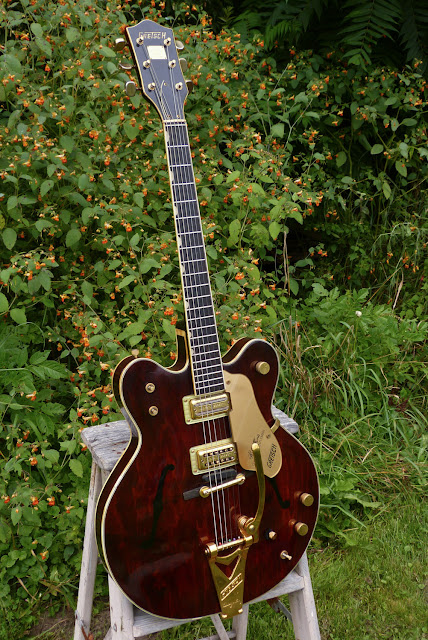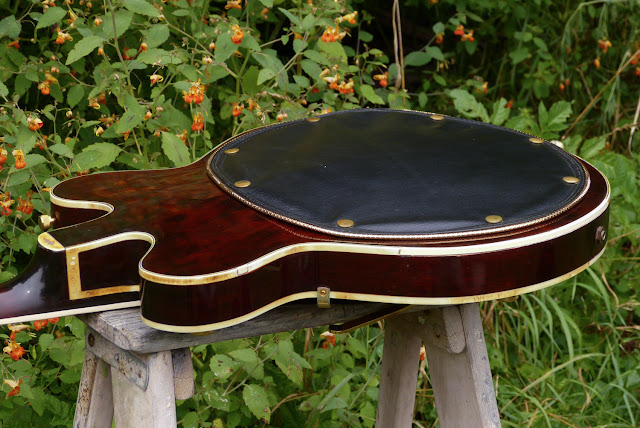1967 Gretsch 6122 Chet Atkins Country Gentleman Hollowbody Electric Guitar
Gretsch models underwent lots of transformations from the mid-'50s through the late-'60s. This is an "actual" Country Gentleman (being 17" wide on the lower bout), and compared to earlier models it's thinner front-to-back and has a ton of fret access with its double-cutaway body shape. Compared to something like a Gibson ES-335, the more "Casino" or "330" vibe of the hollowbody construction lends its dual-humbucker configuration a bit more air and sizzle to the voice -- landing it in that old late-'50s Gretsch-sound camp but with the playability bonuses of a late-'60s guitar.
This is a customer's guitar and it was in for a fret level/dress, setup, and some patch-jobs to missing and crumbled binding. Gretsch guitars often have "binding rot" -- which is where the celluloid binding actually starts crumbling and falling apart into little bits and dust. It's a frustrating situation because the best solution is actually the worst -- replacing all the binding. There's something life-sucking about an old guitar with new trim, however, so I did my best to shore it up for the meantime.
After work, this thing plays beautifully (hair above 1/16" E and 1/16" ADGBE at the 12th fret) and is strung with what feel like 11s. It has a 1 5/8" nut width and C/D slim-medium neck profile. The scale is 24 3/8" which puts it on the shorter side and also means it plays slick. The Gretsch-branded Bigsby whammy is the bee's knees -- seriously -- these just feel so good.
This one has the "walnut" finish which is a deep, brown-red-brown. All the hardware is gold-plated and the guitar looks entirely original to me aside from the replacement binding sections. I'm not 100% sure on the bridge base, either.
At this time, Gretsch was making these hollowbodies with no open f-holes. The ones you see here are painted-on.
The truss works as it should.
"Thumb print" inlays flank standard, medium-sized frets. The board is ebony and lightly radiused.
Top switch is the 3-way for pickup selection and the bottom switch is the "mud" switch -- in the center is a bypass while to the "left" or "right" selects muddy tone or even muddier tone. These settings just engage caps of different values -- it's like immediately rolling a tone pot to zero. In a perfect world, Gretsch would've used lower-value caps, but the ones in the stock wiring scheme remove a ton of highs and mids.
The shoulder switch is master volume.
I spy SuperTron!
A FilterTron is at the bridge and this guitar even still has its string-mute gizmo extant (don't ever engage it, though).
That's a sexy Bigsby, isn't it?
Controls here are volume for each pickup, a "kill" switch, and the engaging arm for the string mute device.
Under the vinyl cushion one will find an access port for the electronics and more ply-body real-estate.
Those Grovers sure look the business!
The heel cap shows the binding rot pretty well. Under it is a circle of different-colored finish that shows Gretsch's factory solution for solving future-drifting-joints -- put a big old dowel in it!
Here's one tiny patch to a completely-crumbled section. It's better than the jagged edges and gaps that were here before.
Here's another. I mostly wanted to stabilize the sections that were failing rather than try to match them perfectly. It's bad enough just getting into a section without the rotted bits just falling off in an avalanche of plastic-dust all around it.
The largest replaced section is on the lower-bout rear.
Here are some patches I made with bits of neck binding that came off. Though it's hard to see in the photos, the entire treble side of the neck's binding is replacement.































Comments